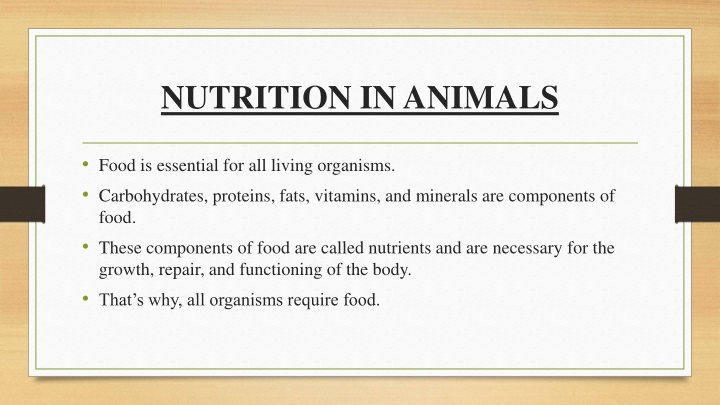
Nutrition in Animals: The Digestive Process Explained
Learn about nutrition in animals and how food is essential for their growth and functioning. Explore the process of digestion in the human digestive system, where complex food components are broken down into simpler substances for absorption and utilization.
Download Presentation

Please find below an Image/Link to download the presentation.
The content on the website is provided AS IS for your information and personal use only. It may not be sold, licensed, or shared on other websites without obtaining consent from the author. If you encounter any issues during the download, it is possible that the publisher has removed the file from their server.
You are allowed to download the files provided on this website for personal or commercial use, subject to the condition that they are used lawfully. All files are the property of their respective owners.
The content on the website is provided AS IS for your information and personal use only. It may not be sold, licensed, or shared on other websites without obtaining consent from the author.
E N D
Presentation Transcript
NUTRITION IN ANIMALS Food is essential for all living organisms. Carbohydrates, proteins, fats, vitamins, and minerals are components of food. These components of food are called nutrients and are necessary for the growth, repair, and functioning of the body. That s why, all organisms require food.
Do animals make their own food? No! Animals cannot make food on their own. That s why they depend on other organisms for food. This type of nutrition is called heterotrophic nutrition.
Now, once animals eat food, what happens to it inside their body? The components of food such as carbohydrates are complex substances. These complex substances cannot be utilized as such. Digestion is the process of breaking down food into simpler substances so that our body can absorb and use it.
Human Digestive System We take in food through the mouth, digest and utilise it. The unused parts of the food are excreted. The food passes through a continuous canal which begins at the buccal cavity and ends at the anus.
The canal can be divided into various compartments: (1) the buccal cavity, (2) foodpipe or oesophagus, (3) stomach, (4) small intestine, (5) large intestine ending in the rectum and (6) the anus. These parts together form the alimentary canal (digestive tract). The food components gradually get digested as food travels through the various compartments.
The various glands associated with the canal such as salivary glands, the liver, and the pancreas secrete digestive juices. The digestive juices convert complex substances of food into simpler ones. The digestive tract and the associated glands together constitute the digestive system.
